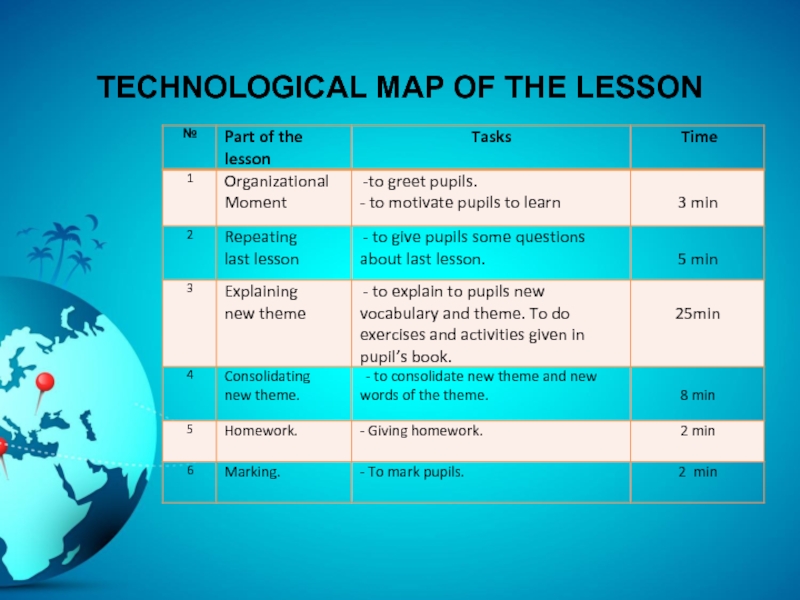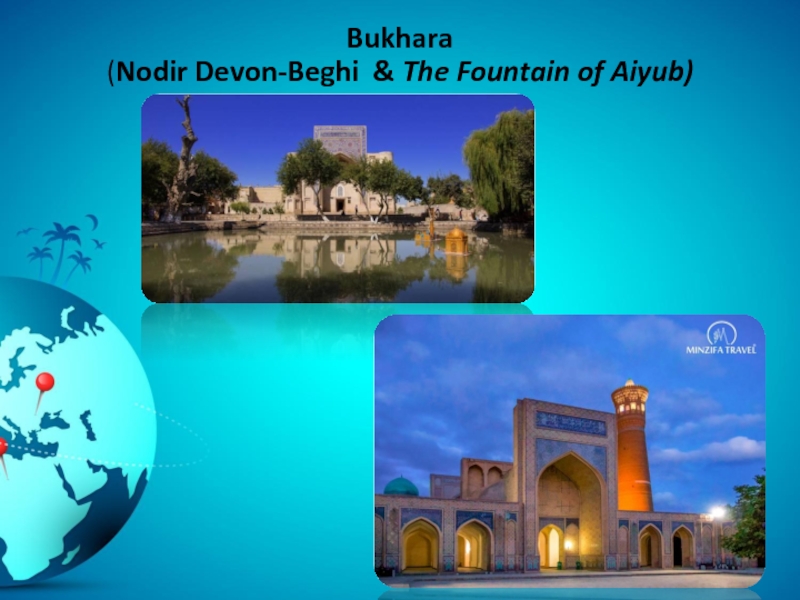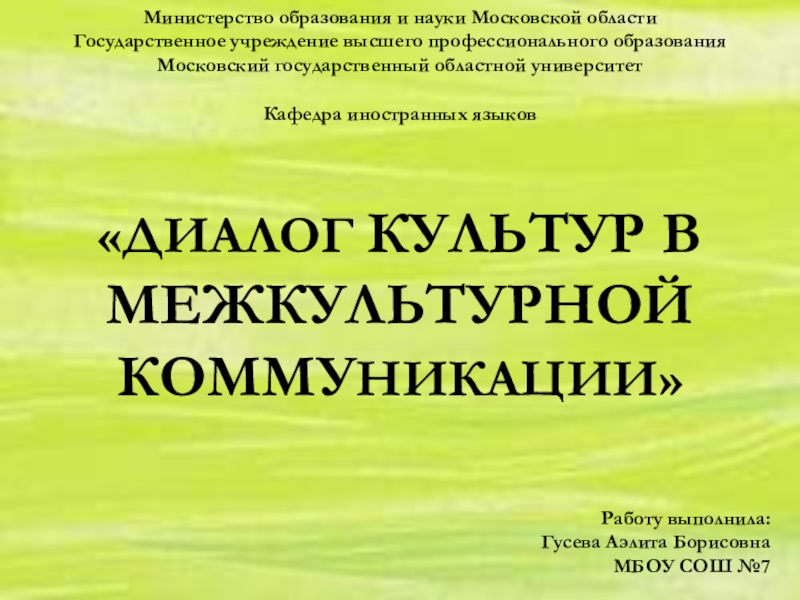- Главная
- Разное
- Образование
- Спорт
- Естествознание
- Природоведение
- Религиоведение
- Французский язык
- Черчение
- Английский язык
- Астрономия
- Алгебра
- Биология
- География
- Геометрия
- Детские презентации
- Информатика
- История
- Литература
- Математика
- Музыка
- МХК
- Немецкий язык
- ОБЖ
- Обществознание
- Окружающий мир
- Педагогика
- Русский язык
- Технология
- Физика
- Философия
- Химия
- Шаблоны, фоны, картинки для презентаций
- Экология
- Экономика
Презентация, доклад на тему Урок-презентация по английскому языку на тему Uzbek tourism 11 класс
Содержание
- 1. Урок-презентация по английскому языку на тему Uzbek tourism 11 класс
- 2. So, let’s discover yourself
- 3. Theme: Uzbek TOURISM
- 4. Theme: Uzbek Tourism Date:
- 5. Theme: Uzbek TourismLearning outcomes: At the
- 6. CompetencesSubject competencyForeign language collaborationLinguistic competencySociolinguistic competencyPragmatic competency
- 7. TECHNOLOGICAL MAP OF THE LESSON
- 8. Main part. Activity 2.
- 9. Post activity Activity 3. T.8. 3. Listen
- 10. - ed VS –ing adjectives
- 11. - ed VS –ing adjectivesPre ActivityActivity 1.
- 12. Bukhara (Nodir Devon-Beghi & The Fountain of Aiyub)
- 13. Bukhara (Nodir Devon-Beghi )Activity 6. Read
- 14. Bukhara (The Fountain of Aiyub)Post activity.The Fountain
- 15. Activity 6. Read the following
- 16. Creative home work
So, let’s discover yourself
Слайд 4
Theme: Uzbek Tourism
Date:
Subject: English
Grade:
Teachers: Kudratova Dilorom
Estimated time: 45
minutes
Educational: -to improve pupils’ awareness of historical and famous places of Uzbekistan, Uzbek tourism;
Developing: -to develop pupils’ listening and speaking skills, develop to report own ideas, communicative skills; listening for main information
Socio-cultural: - to raise awareness of different cultures, teaching to respect them
Educational: -to improve pupils’ awareness of historical and famous places of Uzbekistan, Uzbek tourism;
Developing: -to develop pupils’ listening and speaking skills, develop to report own ideas, communicative skills; listening for main information
Socio-cultural: - to raise awareness of different cultures, teaching to respect them
Слайд 5Theme: Uzbek Tourism
Learning outcomes: At the end of the lesson
pupils will be able to speak about Uzbekistan tourism, sightseeings of Uzbekistan
Type of the lesson: non-standard, mixed, modern
Method of the lesson: individual, group work, pair work
Equipment: English 11 Pupil’s book, the DVD, pictures of famous cities of Uzbekistan
Type of the lesson: non-standard, mixed, modern
Method of the lesson: individual, group work, pair work
Equipment: English 11 Pupil’s book, the DVD, pictures of famous cities of Uzbekistan
Слайд 6Competences
Subject competency
Foreign language collaboration
Linguistic competency
Sociolinguistic competency
Pragmatic competency
Supporting
competency
Collaboration
Skilled communication
Self-regulation
Real world problem and innovation
Knowledge construction
Use of technology for learning
Collaboration
Skilled communication
Self-regulation
Real world problem and innovation
Knowledge construction
Use of technology for learning
Слайд 8 Main part. Activity 2. Match the words from box A with the
words from box B to make collocations.
Слайд 9Post activity Activity 3. T.8. 3. Listen to four people describing where
they live and complete the table below. Use the correct adjectives from exercise 1.B for the “type of place” column. Write down any words that helped you decide.
Слайд 11- ed VS –ing adjectives
Pre Activity
Activity 1. Use the adjectives, -ed
or -ing. Choose the best option to complete each sentences. Use the verbs in the brackets to form adjectives.
(to excite) My most experience as a teenager was travelling to Samarkand. I remember I was so that couldn’t sleep the night before my flight. 2. (to surprise) I was really when I got to the airport and found out that one of my friends was travelling with me. 3. (to worry) My friend told me that she was a little bit . 4. (to relax) I advised her to listen to some music. Soon we both felt more . 5. (to interest) I found out my friend is in ancient places. So, we visited some historical buildings. Our stay in Samarkand was extremely . Answer key:
Exciting, excited 2. Surprised 3. Worried 4. Relaxing, relaxed 5. interested, interesting
(to excite) My most experience as a teenager was travelling to Samarkand. I remember I was so that couldn’t sleep the night before my flight. 2. (to surprise) I was really when I got to the airport and found out that one of my friends was travelling with me. 3. (to worry) My friend told me that she was a little bit . 4. (to relax) I advised her to listen to some music. Soon we both felt more . 5. (to interest) I found out my friend is in ancient places. So, we visited some historical buildings. Our stay in Samarkand was extremely . Answer key:
Exciting, excited 2. Surprised 3. Worried 4. Relaxing, relaxed 5. interested, interesting
Слайд 13Bukhara
(Nodir Devon-Beghi )
Activity 6. Read the following two passages below
and do the
TRUE (T) /FALSE(F)activity
A. Nodir Devon-Beghi
The most famous square in the old part of Bukhara is the Lyabi-Havuz (“Lyabi” means “bank of a river”, “Havuz” – a pool). Lyabi-Havuz is the most beautiful and popular place in the city. The history of this place is very fascinating. Nodir Devon-Beghi, a vizir (a minister) of the Bukhara Emir, decided to get married. On his wedding day he presented his bride with only one pair of earrings. His sweetheart took offence. “My groom is not from a poor family, he could have given me a more expensive present.” But the vizir kept silent. Several years later, Nodir Devon-Beghi built a mosque, medrassah and a few other buildings. His wife said to him: “You had no money for an expensive wedding and presents, but you have found plenty for your buildings! Her husband answered her: Darling, look in your jewellery box. The wife took a look and did not see even one earring. “What does this mean? We were robbed!” “Darling, everything which has been built here was built at the expense of your earrings. You did not appreciate my present, so please appreciate what has been built at the expense of it.”
TRUE (T) /FALSE(F)activity
A. Nodir Devon-Beghi
The most famous square in the old part of Bukhara is the Lyabi-Havuz (“Lyabi” means “bank of a river”, “Havuz” – a pool). Lyabi-Havuz is the most beautiful and popular place in the city. The history of this place is very fascinating. Nodir Devon-Beghi, a vizir (a minister) of the Bukhara Emir, decided to get married. On his wedding day he presented his bride with only one pair of earrings. His sweetheart took offence. “My groom is not from a poor family, he could have given me a more expensive present.” But the vizir kept silent. Several years later, Nodir Devon-Beghi built a mosque, medrassah and a few other buildings. His wife said to him: “You had no money for an expensive wedding and presents, but you have found plenty for your buildings! Her husband answered her: Darling, look in your jewellery box. The wife took a look and did not see even one earring. “What does this mean? We were robbed!” “Darling, everything which has been built here was built at the expense of your earrings. You did not appreciate my present, so please appreciate what has been built at the expense of it.”
Слайд 14Bukhara (The Fountain of Aiyub)
Post activity.
The Fountain of Aiyub
A long time
ago in the Central Asian desert, where the city of Bukhara is situated, the people were dying of thirst. There was not even a single drop of water to be found. One day, the people were so thirsty, that they all sat down and prayed. They looked at the heavens and asked God for rain. It wasn’t long before he sent a messenger to rescue them. The messenger’s name was Aiyub. He had a stick and with it he struck the earth. At the place where he struck the earth, a hole suddenly appeared and a fountain gushed forth. It wasn’t long before they discovered the great cures that could be achieved by drinking this water. The people were so happy that they built a beautiful shrine there. Since those days, many people have been visiting the well to partake of the refreshing clear, clean, healing water, and to pray in thankfulness to God.





















